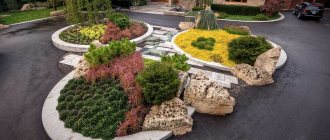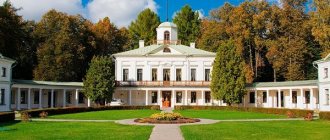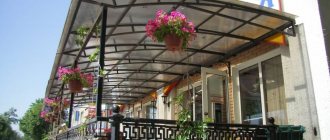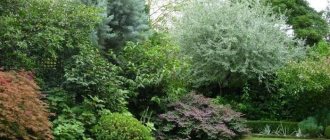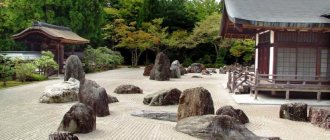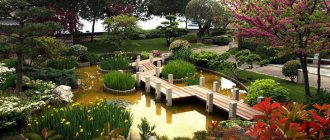design "
The English style in landscape design is one of the classic trends in the design of a garden or park. It appeared in the 18th century in England, and was created as a counterbalance to the French “orderly” style that was widespread at that time. Both of them are two facets of classicism. Unlike the Versailles style with its deliberately straight paths and intricately trimmed bushes, the English style has become the personification of people's closeness to nature.
English style traditions
The first masters of landscape design, who began to design gardens and parks in the English style, drew inspiration from the landscapes of the French artists Poussin and Laurent. Their paintings at that time were considered the embodiment of an idealized picture of complete natural harmony.
English landscape design is characterized by simplicity of lines and elegance of forms; it seems to balance on a fine line between sophistication and excessive pomp. It was formed over two eras - Georgian and Victorian. It became widespread in the era of romanticism, based on the cult of nature and admiration for its majestic beauty.
Important! The traditional layout of English garden landscape design is based on a natural look, naturalness and soft smooth lines. This style is as close as possible to the natural European landscapes, so that just by stepping outside the threshold of the house, you can find yourself in the lap of nature.
Main features
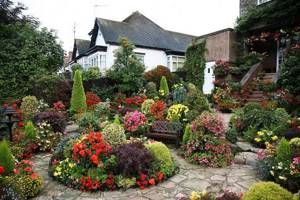
With the help of the English garden, there is an opportunity to completely blur the line between wild nature and the progress achieved to date. Thanks to this, this exterior style is enjoying unprecedented success around the world.
First of all, an English garden is built according to a geometry that cannot be seen with the naked eye. There is a clear structure here, thanks to which all the paths converge to one center, and all the circles and rectangular shapes are correctly combined. This allows you to create a feeling of completeness and order in the garden.
In order to create a real English garden, it is recommended to study the features that need to be used in construction. These include:
- Low hedges of plants, as well as flower walls. All fencing in an English garden is recommended to be made in the form of such structures. This allows you to create the effect of a labyrinth and mystery for park guests. Each element must be clearly organized and executed in the form of a geometric figure. Rectangular or oval shapes predominate here. You should also avoid wild and overly lush plants, which can spoil the overall harmony.
- Types of plants. It is best to use several specific plants that will alternate with each other throughout the entire length of the garden. It is not recommended to plant everything in flower beds. You need to choose 3-4 main types, which can be diluted with different shades.
- Identical finishing elements. To combine the entire exterior into one whole, it is best to use the same material for the construction of all structures. For example, it could be a stone or brick of a certain type and shade.
- Flowering annuals. For flower beds, it is best to use plants whose flowering period is no more than 5-6 months.
If you follow all the described features, you can easily create your own garden in the English style, which will delight the owner and guests for a long time.
Style Features
The garden and the area adjacent to the house look as if a person’s hand had never touched them at all. Trees, bushes and other decorative elements are located on the site asymmetrically and even, at first glance, carelessly. However, this negligence is only an appearance. In fact, any of these areas is thought out to the smallest detail, and all design details are verified and marked on the drawing with mathematical precision.
An English garden is characterized by a combination of open and closed space, where lawns and flower beds are adjacent to groves of trees and shrubs.
Unpredictability is the main feature of the English garden, because it is simply impossible to see it all at once. At every turn of the gracefully curved path, a new, sometimes unexpected landscape opens up.
Since the English style is an imitation of natural landscapes, it does not require large areas at all. To reproduce a piece of wild British nature on your property, all you need is a small piece of land. This makes it especially popular among owners of small cottages and plots.
Landscape design in this style does not require changing the terrain; it is good for its natural beauty and naturalness.
English landscape parks
English landscape parks in the 18th-19th centuries.
Thanks to the industrial revolution and the development of the fleet, England in the 18th - early 19th centuries. became the leading economic power in the world and spread its influence to North America, Australia, and the countries of the East. In the growing country, construction of housing and parks began.
Landscape parks that replaced regular ones differ from them not only in compositional techniques, but also in philosophy. Linear plantings of trees and shrubs gave way to group plantings, and arrays of green spaces with natural contours, clearings and lawns of free outlines appeared. The desire to imitate nature was manifested in the free planning of parks with the identification of relief features, in the creation of reservoirs with winding banks, and curvilinear park paths.
The parks reproduced picturesque natural landscapes. However, this was not a simple “ennoblement” of natural landscapes; man-made landscape compositions of landscape design were created in which there were no random elements. A thoughtful balance of open, semi-open and closed spaces was created. Pedestrian paths were laid, along which one could observe a successive change of landscape paintings. To strengthen the connection of parks with the surrounding landscapes, ditches were installed instead of fences or hedges were camouflaged with greenery.
The 18th century is called the Age of Enlightenment. This is the period of idealization of the “golden age” of antiquity. The parks housed a variety of romantic structures - ruins, grottoes, hermitages (hermitages); a rural idyll was imitated with decorative pastures of cows and sheep, and “peasant” dwellings. The development of landscape gardening art was significantly influenced by the works of landscape painting by such artists as Claude Lorrain, Nicolas Poussin, Antoine Watteau, Honore Fragonard and others.
It was during this period that Europeans became acquainted with Chinese gardening and landscape art, which captured the imagination of European travelers. Books were published with excellent engravings of Chinese imperial gardens and parks.
At the same time, English landscape parks are not borrowing the techniques and principles of Chinese park construction; English landscape parks express their own idea of the beauty of nature.
A typical example of an English landscape park is Stowe Park, located in the Buckingham area (about 100 km from London). It was created on the site of a regular park, the redevelopment of which began in 1714 by Charles Bridgeman, and was completed in 1738 by William Kent (1685-1748) and his student Lancelot Brown (1716-1783). In plan, the park has the shape of an irregular trapezoid. Behind the palace, located in the depths of the park, there is a large meadow, and behind it - a lake. The park features picturesque landscapes with multi-dimensional perspectives, and skillfully placed green spaces that create a play of light and shadow. When creating the park, the technique of optical inclusion of adjacent landscapes in the park composition was used, thanks to breaks in the walls surrounding the park. Park structures: the temples of Bacchus, Venus, Friendship, the Palladian Bridge - served as an example for numerous imitations.
Kew Park in London
, located on the banks of the Thames, covers an area of 160 hectares. In the formation of its layout and landscape compositions from the beginning of the 18th century. took part: Bridgeman, Chambers, V. Kent, V. Ayton, L. Brown. Thanks to the efforts of J. Banks and D. Hooker, a rich collection of plants brought from different continents was collected in the park’s greenhouses and nurseries. In 1841, the park was declared a National Botanical Garden by royal decree. Currently, it is also a World Cultural Heritage Site.
The theorist and practitioner Humphrey Repton (1752-1817) had a great influence on the development of the landscape direction in European gardening landscape art. He wrote a well-known treatise on park design, published in 1803, and formulated the principles of landscape design for landscape parks: the natural beauty of the landscape should be emphasized and its shortcomings should be hidden; the layout should be free; park landscapes must be created in such a way that the illusion of their natural origin arises; all elements of the park must be subordinated to a single concept.
From England, landscape gardening art spread throughout Europe. In the XVIII-XIX centuries. landscape parks became widespread in Germany, France, Russia and other countries. Theoretical works and practical guides on landscape park construction were published. During this period, many regular parks were converted into landscape ones.
Flowers
The English garden is characterized by multi-tiered flower beds, placed in a chaotic order, without any symmetry or system. It creates the effect that all these bright flowers appeared in the flower beds on their own, and that people did not plant or grow them at all. And thanks to the use of flowering plants with different flowering periods, flower beds and flower beds look picturesque from early spring to late autumn.
The following plants look good in flowerbeds decorated in English style:
- delphiniums;
- lilies;
- dahlias;
- gladioli;
- petunias;
- heleniums;
- phlox;
- daisies;
- irises;
- peonies;
- cornflowers;
- decorative tobacco.
Next to these flowers, medicinal and some garden plants often grow in the same flowerbed. Wild flowers, such as clover or dandelions, are also planted in flower beds. This gives the flowerbed a “wild”, natural look.
The English landowners who were the owners of such gardens gave preference to the most persistent and unpretentious of flowering plants. In flower beds they were planted in rows, according to height. The first row, located close to the border, consisted of low-growing plants. Behind it grew taller flowers, their height increasing from row to row. All plants are arranged in height, from short to tall. Thanks to this, it was possible to admire them all, since they did not block each other.
Roses are an important attribute of the English garden. They are traditionally planted near the house. There are also small climbing roses that border window and door openings. Climbing roses can entwine trellises and arbors in the garden.
Important! The lawn is no less important detail of English landscape design than flower beds and flower beds. In addition to grass and cereal plants, wild flowers such as poppy, field cornflower, meadow chamomile, large-flowered flax, and nemesia are planted on them. Bulbous flowering plants are also planted on lawns: tulips, scillas, daffodils, cyclamens, crocuses.

Flowers
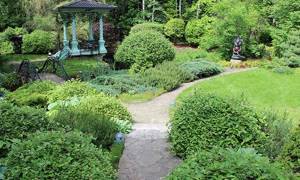
Shrubs
English landscape - build an artificial pond with lilies!
In a garden whose landscape design copies the English style, there should not be clear straight lines, even squares or circles. If you have the opportunity to arrange a pond on your site, which in the English tradition is considered one of the most striking manifestations of style, implement it in such a way that it cannot be distinguished from a natural body of water. Water lilies and lilies will convince you of the naturalness of the pond, and a weeping willow growing on the shore will provide an atmosphere of peace and quiet. The English landscape allows you to place benches in the most secluded parts of the garden - and you can be sure that this will not harm the landscape.
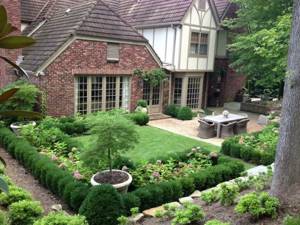
organization of a recreation area: table and chairs near the house in the English garden
Near the house, a terrace made of orange stone and surrounded by a neat wall two or three bricks high will look great.
Lanterns and vases of flowers will look great on this wall. Hanging flowerpots should also be used to decorate the window sills of a garden house. Petunias are well suited as potted flowers. Choose any garden plants that you like best and that are suitable for your climate, but do not forget: in an English-style garden, everything should be natural .
Garden paths in English style
The English park is divided into zones using paths. All paths should lead to some significant place: to a bench, house or gazebo. Often steps are made on such paths to serve a decorative function.
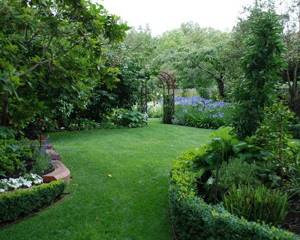
to create an English garden, a smooth lawn is taken as the basis
Garden paths can be paved with any material. At the same time, it is important that the color of the path is combined with the palette of the plants surrounding it, and that it itself looks harmonious in their surroundings.
Water sources for an English-style garden plot
In English parks you can often find small fountains and springs. However, make sure that they are not obviously provocative or of an unnatural color - the eye should not stop at them!

stone path in an English garden
It is clear that all water sources in an English park have decorative functions, but at the same time, it is possible to use individual purely French elements when creating an English-style garden.
For example, having made a terrace, you can drink traditional English tea in the evenings and admire the amazing beauty of the nature of the British garden.
Garden architecture in English style
The small number of artificial structures that are allowed to be placed in an English-style garden must adhere to the basic rule of style - everything should look natural! Therefore, if you intend to install an arch, then make sure that the vines quickly wrap around it. If you need to install a border, then let it be made of natural stone. Paths can be made of gravel or sawn wood. Try to avoid straight lines and clearly defined boundaries - give them the opportunity to disappear into the lawn! A bridge with forged lace handrails will naturally fit into the English landscape, and this method of decoration can be used without a pond. In this case, under it you can plant those plants that love shade.
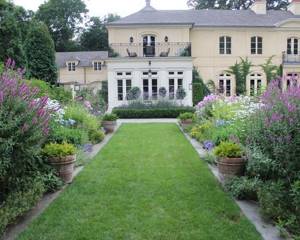
more flowerpots in the English garden
An English-style garden is very similar to a shadow garden. In such a park you will not only enjoy the amazing beauty of the landscape, but also have a wonderful walk in the fresh air!
Shrubs
As in the natural environment, shrubs play a large role in English landscape design. They are planted haphazardly throughout the garden, forming groups of them somewhere, and leaving single plants somewhere. Shrubs are also used to form hedges that border the perimeter of the area and decorate it.
Most used types of shrubs
- Boxwood;
- hazelnut;
- shrubby species of juniper;
- teren;
- barberry;
- quince;
- jasmine;
- rose hip.
Important! Shrubs, both forming a hedge and planted in groups or even one at a time, are not usually trimmed heavily. A certain carelessness of pruning gives them a certain natural charm, so characteristic of the English style in landscape design.
Trees
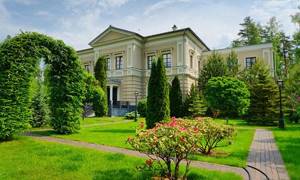
In an English garden, it is customary to plant both deciduous and coniferous trees. Often, they grow next to each other. For example, maple can coexist with spruce and larches, which is not always possible in natural conditions.
Trees are located in groups of different densities and at different distances from one another. This creates the illusion of a natural forest landscape. Preference is given to local species that blend seamlessly into the natural landscape surrounding the garden.
Near the ponds, as well as streams and small rivers flowing through the garden, you can see weeping willows growing above the water. They complement the beauty of the landscape and give it peace and tranquility.
The most common trees in English gardens are:
- ate;
- larches;
- Oak trees;
- maples;
- yews;
- hollies;
- beeches;
- hornbeams;
- linden trees
At the same time, evergreen trees predominate quantitatively, which gives the site a picturesque appearance not only in the warm season, but also in winter.
Fountain
In landscape design, the English style appeared as one of the manifestations of classicism. When decorating gardens, fountains are used, usually in an antique style, but not too pretentious.
Stone bowls or depressions in the ground are decorated with “ancient Greek” statues depicting mythological characters or animals. They organically fit into the overall landscape of the garden, complementing it and making it interesting and “cultivated”.
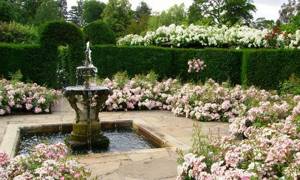
Fountain
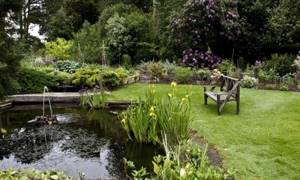
Pond
Pond
It is difficult to imagine a real English garden without a pond, across which there would not be an elegant bridge. A pond on the site is one of the integral features of this style. It has the shape and appearance of a natural pond, since its outlines are devoid of clear forms, which often happens in natural conditions.
The banks of the pond are planted with shrubs and trees; the willow, which bends its branches low above the water, is especially popular. And in the pond itself there are aquatic plants: sedge, cattail, water lilies, reeds. The surface of the reservoir is covered with duckweed, which also gives it a resemblance to a real natural lake. Wooden gazebos
They give the garden an element of mystery and at the same time a certain privacy. Typically, these gazebos are located in the depths of the garden, surrounded by dense growth of bushes and trees. They themselves often turn out to be tightly entwined with wild grapes, ivy or climbing roses.
Important! Wooden gazebos should not be conspicuous: they are hidden behind groups of trees and bushes.
Do you like English-style landscape design?
Yes
No
I want it like in England! Features of the English garden

The garden of the poet William Wadsworth, who lived in the first half of the 19th century, has retained its original layout. It is considered an example of a romantic English garden.

We will help you in choosing style and color solutions for paving stones
More details
What about “there”? How does the English approach differ from our usual view of the estate? How should she be treated? It is the approach and views on gardening that differ radically.
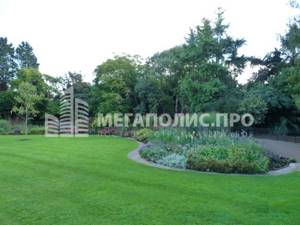
Mixborder all-round view in Regent's Park, London. An example of a traditional approach to creating compositions.
The culture of caring for your own piece of land, even a very small one, goes back to the Middle Ages in England. There are still private gardens that have preserved the layout and composition of plants “as in the 16th century.”
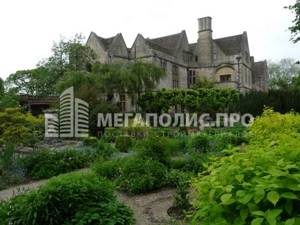
There are many examples where one family has owned an estate for three or four hundred years. Even simple and relatively poor people, farmers, had their own stone house, which was inherited, and with it a plot.

Village houses in Bibury, Cotswolds. The village is considered one of the most characteristic of these places, residential houses, 17-18 century.
The sacredness of property rights gave the owners the confidence that an oak tree planted today would not be uprooted tomorrow, and that their great-grandchildren would see it.
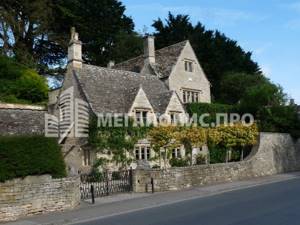
A modest old house in Bibury, the pine tree in the backyard is at least a hundred years old. The hedge of clipped maples in the foreground will reach maturity in 10 years, not earlier.
Therefore, the British are sure that plants are serious. The type of site is as important as the renovation of a building or the class of a car. An uncut lawn is equal to unwashed windows with dirty curtains: a shame for the owners. Only the poor, the lumpen, do not take care of their land, even if it is 10 square meters. meters in front of the windows. This is very noticeable in any English city.

Courtyard of a private house, Bristol. There is not a single unkempt piece of land: either tiles or plants.
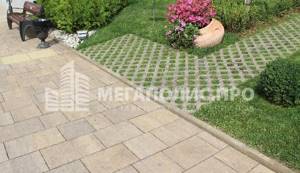
1759 rub. per sq. m.
Antara Choice 60 mm Dolomite
Go to catalog
Antara paving slabs from the Artificial Stone collection are well suited for arranging garden paths in the English style.

2185 options for paving slabs in our showroom from 12 factories
More details
A garden is not an area for growing food, although there are vegetable gardens in modern gardens. A garden is a place of relaxation, beauty, a place of peace and a source of pride, not only for the owner, but also for the owner. Many famous English landscape designers are men, both in the past and now.

Home of the poet William Wadsworth. It is known that he designed his garden himself and worked in it himself.
An expensive house without a well-kept plot is nonsense.
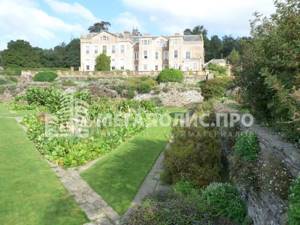
Hestercombe, a garden once designed by Gertrude Jekyll, one of the creators of English landscape design. Parterre, formal part.
Moreover, since your site is beautiful, you need to let others look at it: fences and driveways usually allow you to do this.

Private house, Lake District, view from the street. The house is very simple and small, a modest home for a poor family.
A guest will not enter the site without an invitation, but it is usually possible to have a look. Therefore, the garden is often planned at key viewing points outside the site.

The facade of this small building adorns the entire street. Cotswold. There is a green fence, but it does not block the view: you can come up and look into the yard.
In Russia the situation is different: most often all the viewpoints are located inside, and there is a fence around the perimeter so that not even a fly can fly through. Private English gardens are open to the public on certain days and times, sometimes only a few times a year, but you can visit them if you wish.
“Well, we’ll plant flowers, we’ll create this diversity” - this is a very common approach to designing flower beds in Russia. The brighter it is, the better it seems. “Oh, I don’t have a flower like this yet, I’ll buy it” - this is our second textbook approach. The more exotic the better. There is neither one nor the other misconception in England.
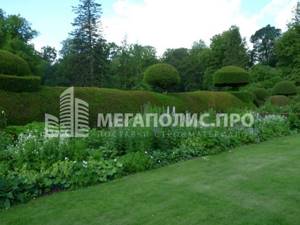
Classic border, private estate, Lake District. The beginning of summer, white and blue colors prevail: cyanosis, delphiniums, geraniums, speedwell.
Better - more harmonious. Fewer different colors. Fewer textures and shapes. Reliability is better than exoticism, predictability is better than extravagance.
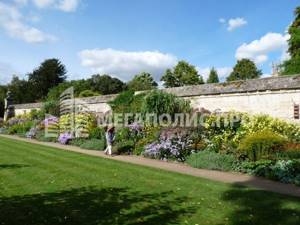
Oxford University Botanic Garden. October. Pale and dark lilac clumps of New Zealand aster of various sizes. On the right side of the mixborder, goldenrod and helenium are clearly visible.
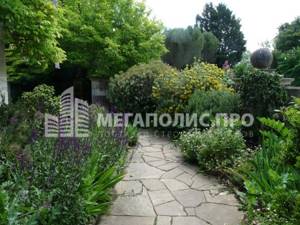
Private garden, Somerset. In the foreground is a dark blue salvia - sage. On the other side of the path is a pale blue geranium. The leaves of irises and kupena are visible, and aconites are blooming.
The composition of plants can be very simple, but their combination should strive for the ideal. Two colors in a composition - usually no more.

Blue-blue mixborder. Or one for accents and the other two – soft, discreet, for filling plants. Favorite geraniums, foxgloves, poppies, roses, ivy for walls, yew and boxwood for hedges: the national idea blooms on every corner. In modern mixborders, mantle and even thistle are often found: what we always considered weeds and carefully weeded.
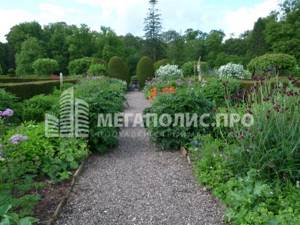
The scarlet accent is the oriental poppy, on both sides of the path there are large bushes of thistles that have not yet bloomed, and a cuff in the border. It is often said that the English style is natural. This is true, but not the whole truth. Plants should be cut in a way that is convenient for the owner, as it will be beautiful and in such a way as to create the best composition. Therefore, topiaries and green hedges are an indispensable attribute of almost any garden.

Private estate, Lake District. Entrance to the “garden behind the walls”, walled garden, a common element of large estates. This fence is about two hundred years old, the forged lattice is modern.
It would never occur to anyone to fence off their area facing the road with corrugated sheet metal or even a blank brick wall. Instead, make a hedge of trimmed thujas 4 meters high, through which nothing can be seen and very little can be heard - please. True, of course, growing it is more difficult and takes longer than installing a corrugated sheet fence.
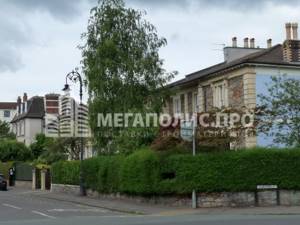
Bristol, an ordinary street in an area where the poor middle class lives. Some of the hedges are neatly trimmed, but some are overgrown: some neighbors are better gardeners than others.
The desire to follow nature in modern English gardens is very noticeable: not the entire lawn is cut, but part of it. Special areas with tall grass are created, filled with wildflowers and other flowers, imitating a blooming meadow.

Private garden, Somerset. The park is about two hundred years old, and some of the lawns are topiary. Wild life - dragonflies, butterflies, beetles, frogs must live somewhere.
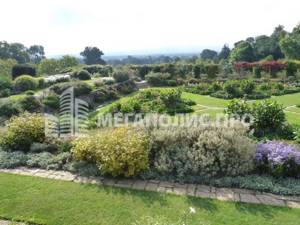
Hestercombe. Soft combinations of colors in the border. The contrast of yellow and blue breaks up the neutral silver.
Small is beautifull, small is beautiful. The British literally understand it this way: it is not necessary to make an alpine slide measuring 3x8 meters if the goal is to admire tiny saxifrages. Moreover, most of the plots are small.

This flowerbed table is often used for planting small, delicate alpine plants. Excessive moisture is eliminated and everything is perfectly visible.
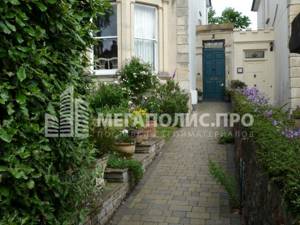
Entrance to a town house, Bristol. Container plants are a popular solution for small spaces. Unobtrusive but well-executed paving adds completeness to the whole picture.
The UK is very rich in stone and poor in wood, so stonework can be seen everywhere: house walls, fences, paving paths, patios, ponds.
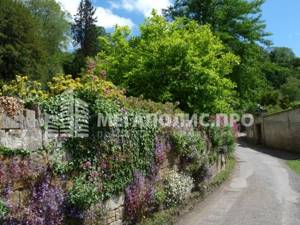
Somerset, private garden. Armeria, ivy, lobelia, saxifrage.
Since the landscape is most often hilly and there are few completely flat areas, retaining walls, stairs and steps are a very common element of garden design.

Plants on stairs and walls are not considered undesirable for the building. There is no frost or ice here; there is no need to clean the stairs with a shovel.

Wooden benches
Benches come in both elegant classic and country style. They can be either with a curved back and legs, or deliberately rough, as if made in a hurry by a village craftsman. But the main requirement that they must meet is a harmonious combination with other decorative elements and with the surrounding landscape.

Wooden benches

Sculptures
